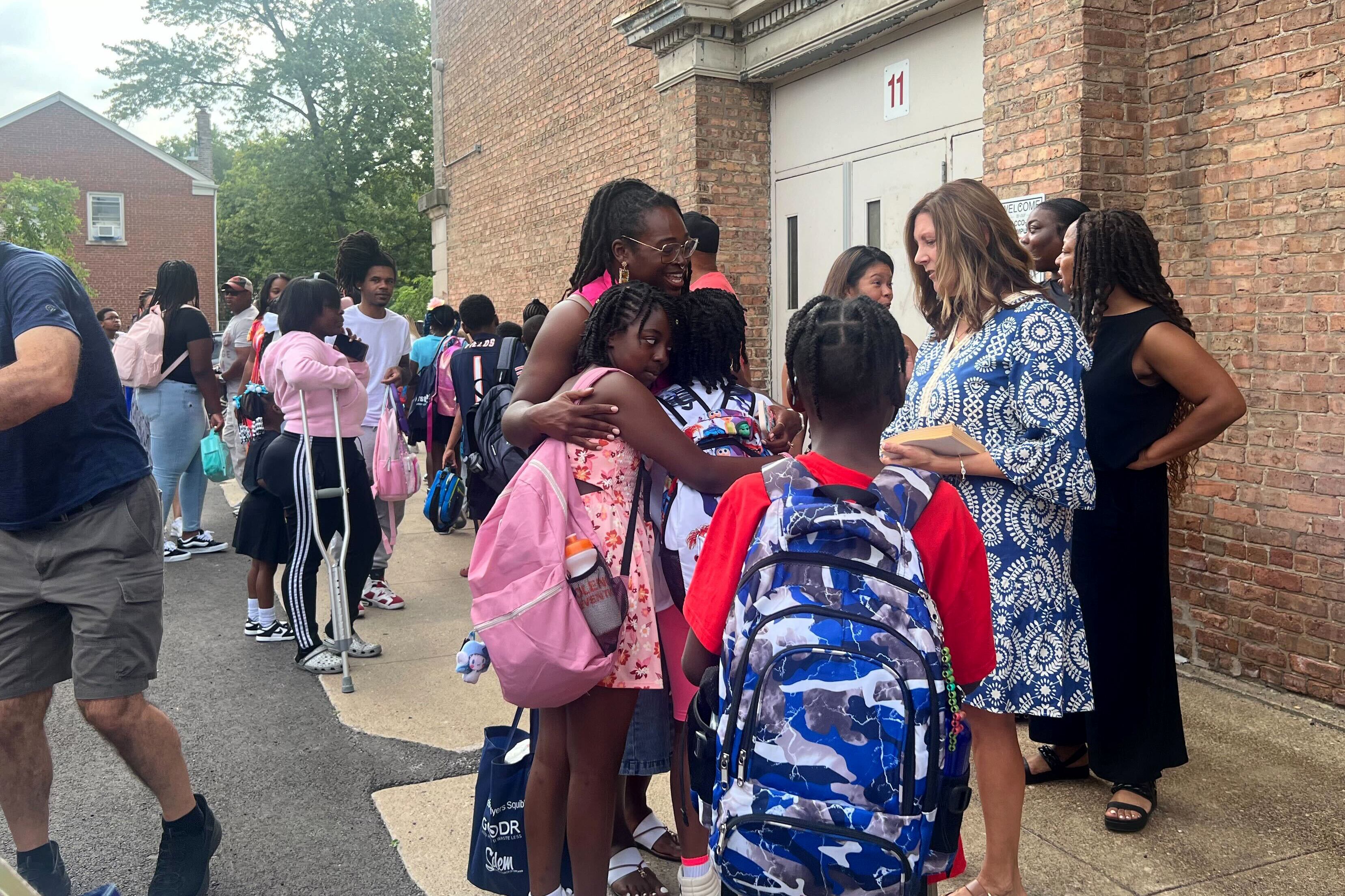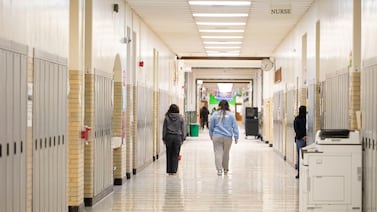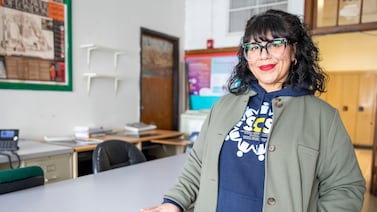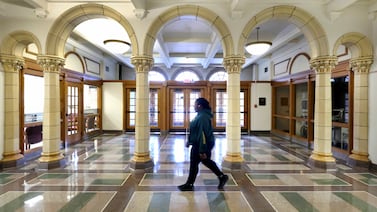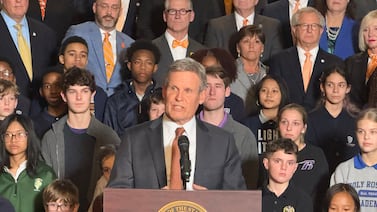As Chicago Public Schools continues contract talks with its teachers union, a pressing question looms: How will the district pay for a new contract — and rein in ballooning budget deficits?
Money from local property taxes, the state, and the federal government fuel the city’s public schools. As the feds’ contribution shrinks with COVID aid running out and state proposals to boost education spending remain modest, Chicago is increasingly looking into its own pockets to find more money.
In recent weeks, the Chicago Teachers Union has repeatedly spoken of a three-pronged solution as it keeps pushing CPS to agree to more of its proposals:
Dip into the district’s reserves.
Bank on an influx of dollars freed up as special taxing districts that siphon property tax revenue to spur development in a specific area expire in the coming years.
Keep lobbying the state to chip in more.
District CEO Pedro Martinez’ administration has said the reserves idea is untenable, a sentiment some school finance experts echo.
“There is no mythical pot of gold, so I hope we can put this to bed,” district CEO Pedro Martinez said at a Monday news conference.
But Martinez agrees the potential new tax revenue expected to flow to the district as so-called tax increment financing districts, or TIFs, end is a promising piece of the district’s fiscal stability puzzle. CPS is projected to see hundreds of millions in additional property tax revenue in the coming years as TIFs expire. But similar to state funding that is ramping up over time, the added TIF boost might not start really moving the needle until after the four years of the teachers contract the district is now negotiating.
Union officials have pointed out that key sticking points at the bargaining table, such as giving teachers more latitude to select their own curriculums, don’t necessarily cost money. But the two sides have yet to reach agreements on educator pay and staffing — the costliest items — as talks enter their eighth month. The CTU has more recently come close to the district’s pay offer, asking for 4% to 5% cost-of-living raises in each contract year.
District officials have held up CPS’ financial limitations to argue they must hold the line in the contentious talks.
The Civic Federation, a nonpartisan fiscal watchdog agency based in Illinois, released a new analysis this week cautioning the new partially elected school board, which takes office this week, of the district’s precarious financial outlook.
The district is at a “critical financial juncture,” the report notes, with growing deficits and costs, declining enrollment, aging and underused buildings, and more than $9 billion in debt.
The report argues for “right-sizing” the district’s $10 billion budget, which added about 7,000 positions largely with one-time federal pandemic relief as enrollment shrank.
Marguerite Roza of the Edunomics Lab at Georgetown University says CPS is not alone in facing budgetary and demographic headwinds, with the end of federal COVID aid, rising costs, and shrinking enrollment. Many are bracing for belt-tightening in the coming years, with little likelihood of extra help from the incoming Trump administration.
“What makes Chicago unique is this push to up the spending now, when the federal relief funds are already gone,” she said.
But Mayor Brandon Johnson and the CTU have been adamantly opposed to cuts they say will hurt the district’s students, and Martinez has shied away from broaching the topic, saying he wants to protect investments that helped students rebound from COVID’s academic toll.
Can CPS dip into its reserves?
In recent weeks, the union has increasingly pointed to a fund balance listed at more than $1.1 billion, which at 10% of the district’s budget is still lower than the 15% called for in district policy.
It’s an amount that has increased in recent years after dropping precariously in the late 2010s. The district has touted that healthier balance in front of credit agencies as it has sought to improve its credit rating and thus lower its runaway borrowing costs. In a memo district officials wrote to the mayor’s office last summer, they noted that CPS remains one of the largest junk bond issuers in the United States, which has meant steep borrowing price tags.
Pavlyn Jankov, a CTU researcher, acknowledges at least some of the reserves are tied up in day-to-day district expenditures because money from property taxes and the state comes in twice a year while payroll and other expenses are ongoing. Still, “it means the district has more flexibility to make financial decisions,” Jankov said.
He said other districts, such as Minneapolis, are dipping into their reserves to soften the financial blow from the expiration of COVID relief funds and ward off some cuts.
But CPS has a consistent cash flow crunch. District officials said Monday the district only has about $66 million in actual cash on hand, or about three days’ worth of operating expenses. Despite a healthier balance on paper, CPS continues to borrow to make payroll and pay vendors through the school year — and continues to shoulder the costs of such short-term borrowing.
Martinez said he fears that if the district, which faces a budget deficit of more than $500 million next school year, “overextends itself” in addressing CTU staffing and pay increase demands, it might have to resort to layoffs, furloughs, and other painful measures.
“We don’t want to be adding positions on the one hand and laying off teachers on the other,” said CPS Chief Talent Officer Ben Felton.
Roza said leaning on reserves to cover ongoing expenses slated to grow over time is irresponsible.
“If you use reserves to pay the first year, next year you have no reserves and no way to pay for contract costs,” said Roza. “You have left the district very, very vulnerable.”
Is more property tax revenue coming as TIFs expire?
Roughly half the district’s operating budget comes from local property taxes. Johnson ran on a promise of not to raise them — a possibility deeply unpopular with residents and the City Council.
A large amount of property in Chicago sits in tax increment financing districts. When money is not used to spur development within each district, the mayor and city council can declare a surplus and send dollars back to taxing bodies, such as CPS.
This year, the district received a record roughly $300 million in TIF surplus money.
But in addition to that surplus, CPS is looking at a more stable potential source of new revenue: freed-up property tax dollars that will begin flowing to the district and other city agencies as 13 TIF districts expire over the coming years.
According to public data provided by the Chicago Department of Planning and Development and first reported by the Chicago Tribune, CPS is projected to see as much as $100 million more in local property tax revenue in 2026 as a result of the expiring TIFs. The projections balloon to more than $600 million past 2031.
In an interview with Chalkbeat last week, Johnson, a former CTU employee and close ally of the union, said the district should count on future property tax revenue to continue growing its staff.
“That’s always been my goal — to ensure that the tax dollars that were designed to support these sister agencies, that those dollars actually show up for the people of Chicago,” he said.
The union and the district agree the end of TIFs will help the public schools, and both have argued the city should let more of TIF districts sunset.
Jankov, the union’s researcher, said the TIF money — from both surpluses and expiring districts — offers a significant and little discussed source of financial stability. It also can help Chicago and the district advocate more forcefully for more state dollars.
“The city is releasing so much more TIF dollars than in the past, and it shows that the city is doing its part,” he said. “CPS can count on this revenue coming in.”
But Martinez, who had requested $190 million TIF surplus dollars more than the district actually got last year, says the city can do more.
“I appreciate the long-term schedule for release, but it’s not fast enough,” Martinez said. “It’s time to release those TIFs for our children.”
CPS officials said much of the $300 million it got in TIF surplus money has already been dedicated to covering the costs of a new support staff contract with SEIU Local 73 and other expenses. That leaves about $139 million to spend on new teacher contract costs.
The district estimates that the cost of its pay and benefits offer to CTU is about $120 million next year, not including some staffing increases and other concessions it has already offered. The extra TIF surplus could also cover a payment to a city pension fund that covers non-teaching CPS staff. District leaders still insist the city, not CPS, should cover that payment.
Ferguson, of the Civic Federation, said the increase in property tax revenues as TIFs expire over time can offer a partial solution to the district’s financial woes. But in the shorter term, these extra dollars represent a relatively small piece of the puzzle.
How much state money can CPS count on?
State dollars make up about a quarter of the district’s operating budget. Illinois has steered more money to the district in recent years and the current budget includes $2.4 billion in state money.
Still, by the state’s own calculation, its funding for CPS is still about $1 billion short of what would be considered “adequate.”
The Illinois State Superintendent’s budget proposal for next school year includes a modest $350 million increase to the evidence-based formula — and signalled possible belt-tightening down the road. That’s the same annual increase lawmakers have been dedicating to K-12 schools since 2017 when it pledged to ramp up education funding. Last year, Chicago got roughly $25 million of the state’s $350 million increase.
Jankov of the CTU said he appreciates that the Civic Federation report nods to state underfunding of CPS.
But, he said, “the report goes to great lengths in looking narrowly through a financial lens instead of looking at needed investments in our students.”
Jankov also criticized the Civic Federation for suggesting the possibility of a state financial takeover — which Ferguson, the budget watchdog’s leader, defended.
Ferguson said the district and new school board need to find a path to fiscal stability to avoid what happened to CPS in 1980. That’s when the state created a finance authority over CPS to help it out of a financial crisis that involved being cut off from the bond market and unable to make payroll.
Ferguson said he doesn’t see a path forward for CPS today that does not involve cuts to staff and other expenses.
“Those are hard and politically loaded conversations,” he said, “and we need to have them now because we don’t want to have them in a state of full-blown crisis.”
Mila Koumpilova is Chalkbeat Chicago’s senior reporter covering Chicago Public Schools. Contact Mila at mkoumpilova@chalkbeat.org.

